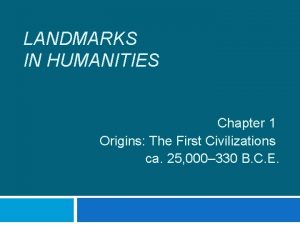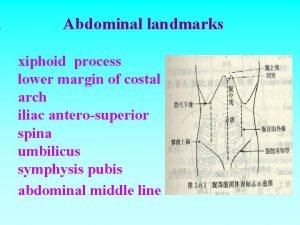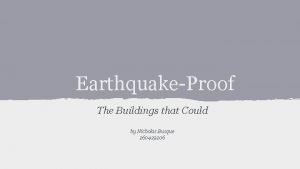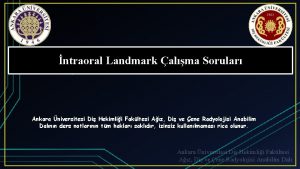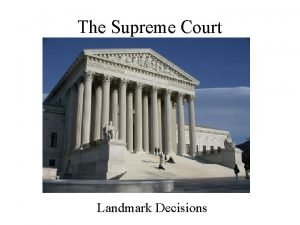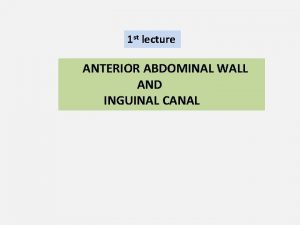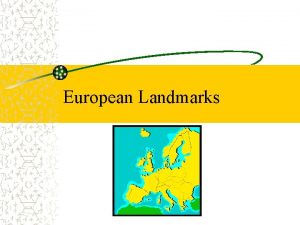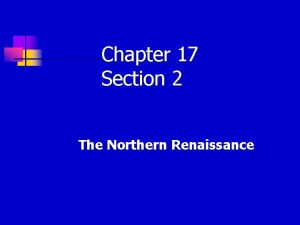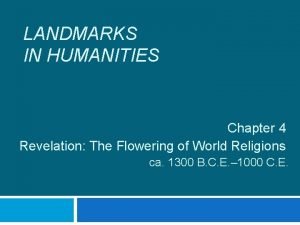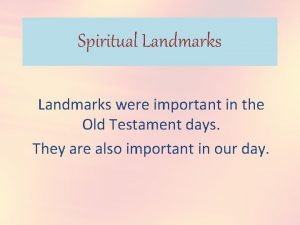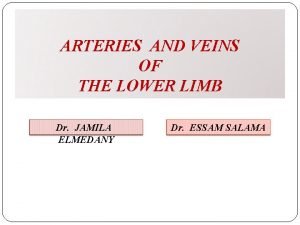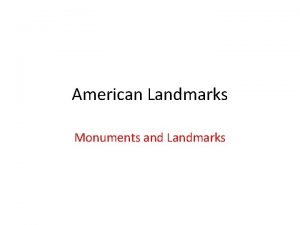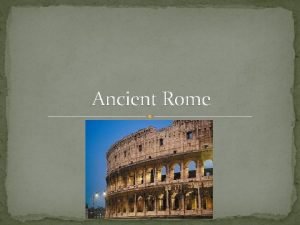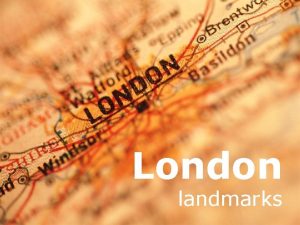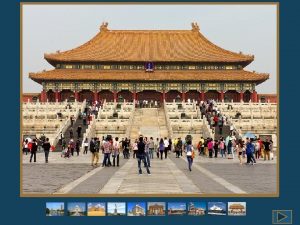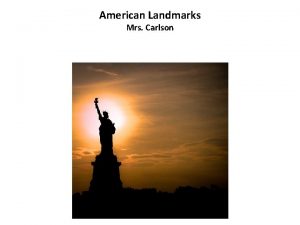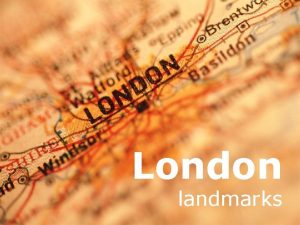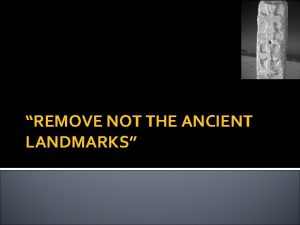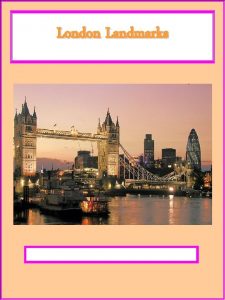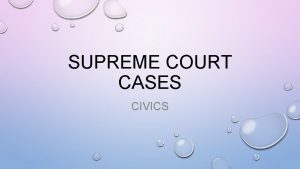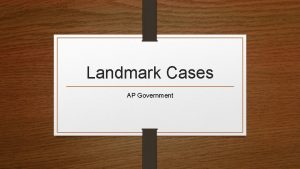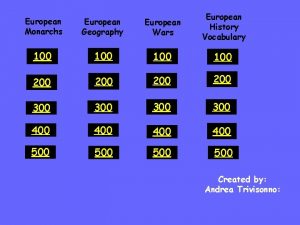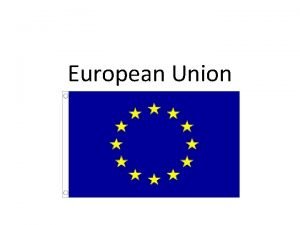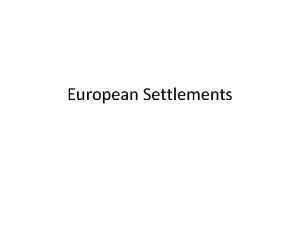European Landmarks What is a Landmark An important




























- Slides: 28

European Landmarks

What is a Landmark? ? ? An important building or monument Often, a building that is significant in history that is protected and maintained by the local or national government

How will we define our Landmarks? WHO- was there a significant figure who built the landmark? WHAT- what materials were used to create the landmark? WHEN- when was the landmark built? WHERE- location of the landmark- city, country WHY- why was this landmark built, what is the purpose?

Information WHO- built by Gustave Eiffel WHAT- made of exposed iron WHEN- built from 1887 -1889 WHERE- Paris, France WHY- built as an attraction for the World’s Fair held in Paris in 1889 with three levels, is 984 feet high, the first level is a restaurant still in

Eiffel Tower!

Information WHO- wealthy widow named Berta di Bernado WHAT- the interior is made of limestone and mortar, with the exterior being covered in marble WHEN- 1173 -1350 (there were many wars that interrupted the project) WHERE- Pisa, Italy WHY- It is a bell tower to accompany the cathedral that it stands next to. It leans because the soil is sand

Tower of Pisa

Information WHO- East German government and soldiers WHAT- built of concreter, it was 12 feet high and 120 miles long WHEN- built in 1961 WHERE- through the city of Berlin, Germany WHY- after WWII, the city of Berlin was shared by allied and Soviet (former USSR) forces; because the East German govt. was so strict, people tried to leave all the time and a wall was built to stop this. This wall came down in 1991 when the Soviet Union broke up

The Berlin Wall

Information WHO- Charles Barry WHAT- made of masonry stone with an iron framework WHEN- 1854 -1856 WHERE- London, England WHY- It was built as a grand addition to the Palace of Westminster, and to keep time for the people The inscription beneath the dials reads 'DOMINE SALVAM FAC REGINAM NOSTRAM VICTORIAM PRIMAM' which

Big Ben

Information WHO- King Ludwig II WHAT- built of stone in a Romanesque architectural style WHEN- 1869 -1892 WHERE- Bavaria, Germany WHY- The castle was built to be a private home for the King, in the most scenic part of Germany This castle was the model for Walt

Neuschwanstein Castle

Information WHO- possible the Druids, a group of Celtic priests, or more likely neolithic, ancient people WHAT- wood and bluestone igneous rock, and sandstone WHEN- 3000 -1000 B. C. WHERE- southwestern England WHY- not fully known, possibly a calendar, possibly a sacred place of

Stonehenge

Information WHO- Ivan the Terrible WHAT- made up of 9 individual chapels, made of red brick with the common “onion dome” design WHEN- 1555 -1561 WHERE- Red Square in Moscow, Russia WHY- built to commemorate Ivan the Terrible's successful military campaign against the Tartar Mongols in 1552

St. Basil’s Cathedral

Information WHO- Roman Emperor Vespasian, and his son Titus WHAT- stones and concrete bricks, finished with marble stone WHEN- A. D. 69 -79 WHERE- Rome, Italy WHY- built as an amphitheater which showcased plays, celebrations and is most known for its gladiator fights

The Colosseum

Information WHO- Napoleon Bonaparte WHAT- stone and marble WHEN- 1833 -1836 WHERE- Paris, France WHY- it was built to honor and commemorate the great and successful army of Napoleon It now serves as a symbol of unity 12 streets radiate out from this point

Arc de Triomphe

Information WHO- Giovanni Bernini WHAT- stone and granite WHEN-17 th Century WHERE- Vatican City, Rome, Italy WHY- an entrance to Vatican City, that leads strait to St. Peter’s Basilica

St. Peter’s Square, cont. The Basilica was built over the spot believed to be where pilgrims and Roman Christians had traditionally venerated the remains of the first Apostle of Christ and first Bishop of Rome -- Simon Peter -- who was crucified upside down atop this spot on Vatican hill, according to tradition, under the Emperor Nero.

St. Peter’s Square- the Vatican

Information WHO- Horace Jones WHAT- stone bearing masonry and iron WHERE- London, England WHEN- 1886 -1894 WHY- serves as a bridge over the Thames River this is actually a drawbridge that opens to allow ships to pass through

London Tower Bridge

Information Who: Built by Athenians in Greece What: Constructed in Doric Style using Marble Considered the finest example of Greek architecture. When: Completed 432 B. C. Where: The Acropolis, Greece Why: A temple for the Goddess Athena

The Parthenon
 Landmark in humanities 5th edition
Landmark in humanities 5th edition Cephalometre
Cephalometre Which is the best area for auscultating the apical pulse
Which is the best area for auscultating the apical pulse Hypochondrium region
Hypochondrium region What are landmark numbers
What are landmark numbers Why buccal shelf area is primary stress bearing area
Why buccal shelf area is primary stress bearing area Torre mayor earthquake resistance
Torre mayor earthquake resistance Linea obliqua interna
Linea obliqua interna Nasal instillation procedure ppt
Nasal instillation procedure ppt Brown v board of education of topeka
Brown v board of education of topeka Deep fascia of abdominal wall
Deep fascia of abdominal wall Landmark machu picchu
Landmark machu picchu Needle syringe parts
Needle syringe parts Landmark college readiness assessment
Landmark college readiness assessment Oral cavity landmarks
Oral cavity landmarks Whatstone bridge
Whatstone bridge What was the first full-sized book gutenberg printed?
What was the first full-sized book gutenberg printed? Landmark option
Landmark option One landmark of early buddhist culture is the
One landmark of early buddhist culture is the The ancient landmark
The ancient landmark How to wardrive
How to wardrive Regio plantar pedis
Regio plantar pedis Pericardial friction
Pericardial friction Palatal anesthesia
Palatal anesthesia Inverted pyramid in news writing
Inverted pyramid in news writing Least important to most important
Least important to most important Newspaper article format
Newspaper article format Ecg landmarks
Ecg landmarks Maxilla bone
Maxilla bone
